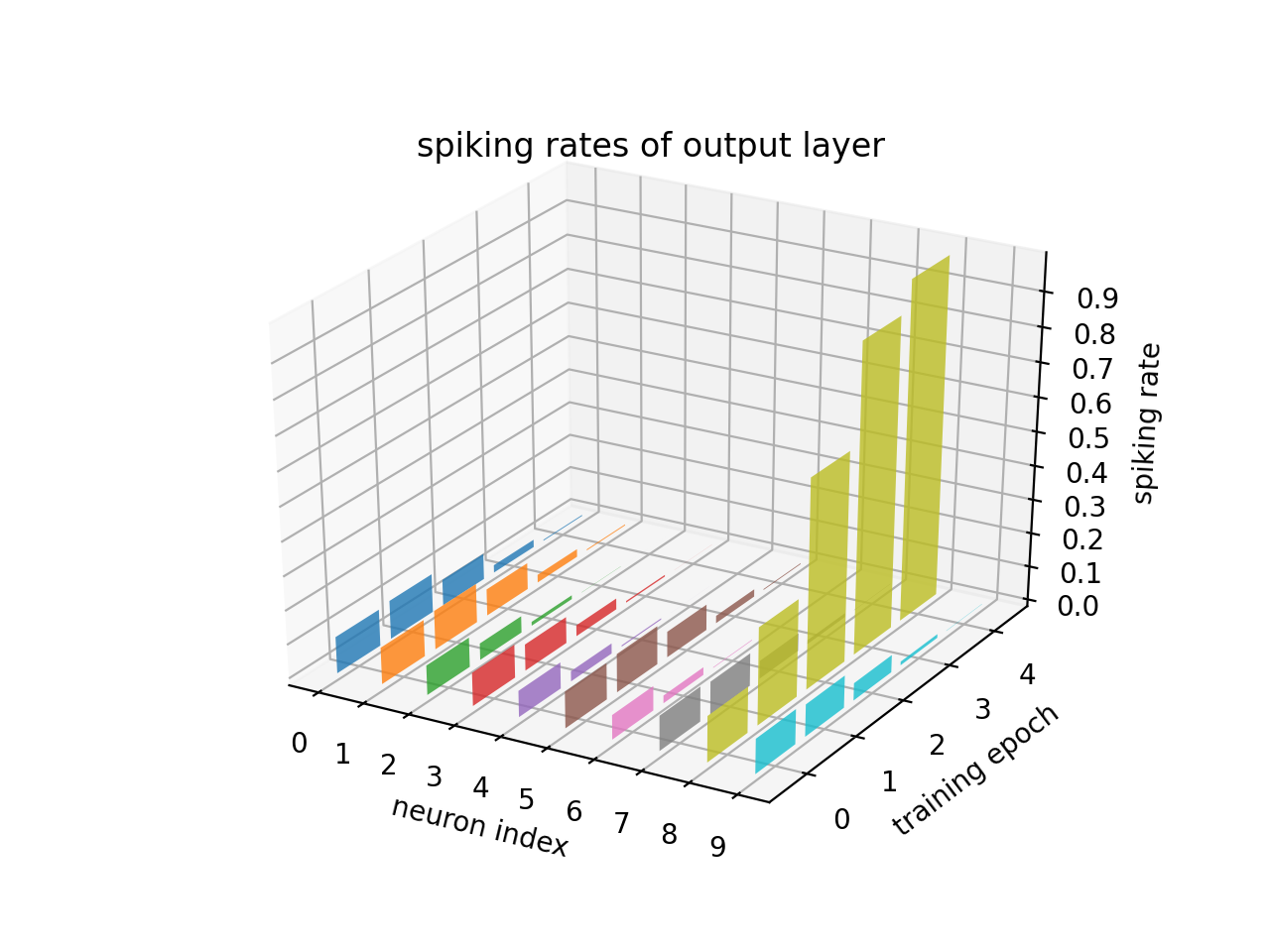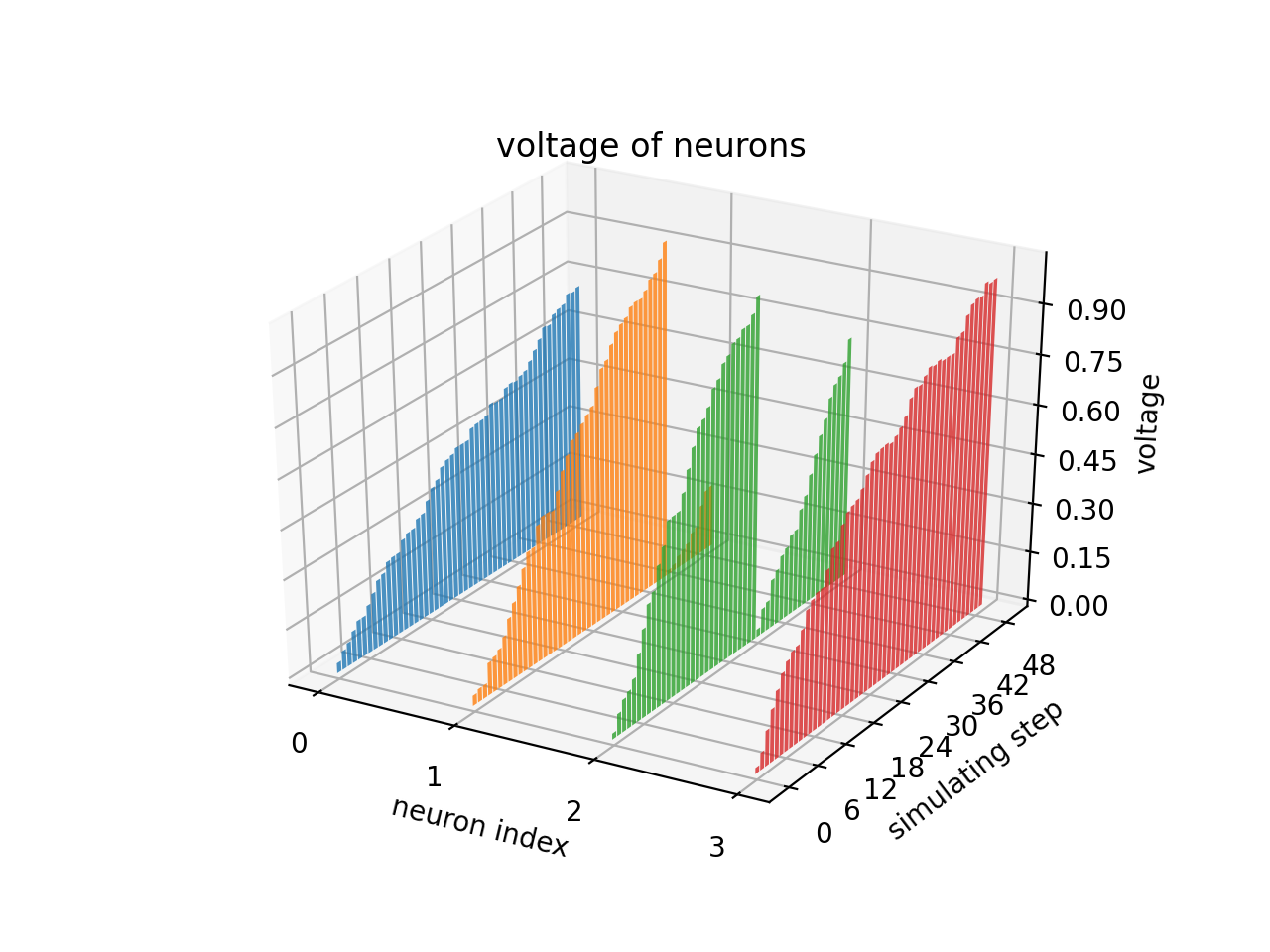spikingjelly.visualizing package
Module contents
- spikingjelly.visualizing.plot_2d_heatmap(array: ndarray, title: str, xlabel: str, ylabel: str, int_x_ticks=True, int_y_ticks=True, plot_colorbar=True, colorbar_y_label='magnitude', x_max=None, dpi=200)[源代码]
- 参数
array – shape=[T, N]的任意数组
title – 热力图的标题
xlabel – 热力图的x轴的label
ylabel – 热力图的y轴的label
int_x_ticks – x轴上是否只显示整数刻度
int_y_ticks – y轴上是否只显示整数刻度
plot_colorbar – 是否画出显示颜色和数值对应关系的colorbar
colorbar_y_label – colorbar的y轴label
x_max – 横轴的最大刻度。若设置为
None,则认为横轴的最大刻度是array.shape[1]dpi – 绘图的dpi
- 返回
绘制好的figure
绘制一张二维的热力图。可以用来绘制一张表示多个神经元在不同时刻的电压的热力图,示例代码:
import torch from spikingjelly.clock_driven import neuron from spikingjelly import visualizing from matplotlib import pyplot as plt import numpy as np lif = neuron.LIFNode(tau=100.) x = torch.rand(size=[32]) * 4 T = 50 s_list = [] v_list = [] for t in range(T): s_list.append(lif(x).unsqueeze(0)) v_list.append(lif.v.unsqueeze(0)) s_list = torch.cat(s_list) v_list = torch.cat(v_list) visualizing.plot_2d_heatmap(array=np.asarray(v_list), title='Membrane Potentials', xlabel='Simulating Step', ylabel='Neuron Index', int_x_ticks=True, x_max=T, dpi=200) plt.show()
- spikingjelly.visualizing.plot_2d_bar_in_3d(array: ndarray, title: str, xlabel: str, ylabel: str, zlabel: str, int_x_ticks=True, int_y_ticks=True, int_z_ticks=False, dpi=200)[源代码]
- 参数
array – shape=[T, N]的任意数组
title – 图的标题
xlabel – x轴的label
ylabel – y轴的label
zlabel – z轴的label
int_x_ticks – x轴上是否只显示整数刻度
int_y_ticks – y轴上是否只显示整数刻度
int_z_ticks – z轴上是否只显示整数刻度
dpi – 绘图的dpi
- 返回
绘制好的figure
将shape=[T, N]的任意数组,绘制为三维的柱状图。可以用来绘制多个神经元的脉冲发放频率,随着时间的变化情况,示例代码:
import torch from spikingjelly import visualizing from matplotlib import pyplot as plt Epochs = 5 N = 10 firing_rate = torch.zeros(Epochs, N) init_firing_rate = torch.rand(size=[N]) for i in range(Epochs): firing_rate[i] = torch.softmax(init_firing_rate * (i + 1) ** 2, dim=0) visualizing.plot_2d_bar_in_3d(firing_rate.numpy(), title='spiking rates of output layer', xlabel='neuron index', ylabel='training epoch', zlabel='spiking rate', int_x_ticks=True, int_y_ticks=True, int_z_ticks=False, dpi=200) plt.show()

也可以用来绘制一张表示多个神经元在不同时刻的电压的热力图,示例代码:
import torch from spikingjelly import visualizing from matplotlib import pyplot as plt from spikingjelly.clock_driven import neuron neuron_num = 4 T = 50 lif_node = neuron.LIFNode(tau=100.) w = torch.rand([neuron_num]) * 10 v_list = [] for t in range(T): lif_node(w * torch.rand(size=[neuron_num])) v_list.append(lif_node.v.unsqueeze(0)) v_list = torch.cat(v_list) visualizing.plot_2d_bar_in_3d(v_list, title='voltage of neurons', xlabel='neuron index', ylabel='simulating step', zlabel='voltage', int_x_ticks=True, int_y_ticks=True, int_z_ticks=False, dpi=200) plt.show()

- spikingjelly.visualizing.plot_1d_spikes(spikes: asarray, title: str, xlabel: str, ylabel: str, int_x_ticks=True, int_y_ticks=True, plot_firing_rate=True, firing_rate_map_title='Firing Rate', dpi=200)[源代码]
- 参数
spikes – shape=[T, N]的np数组,其中的元素只为0或1,表示N个时长为T的脉冲数据
title – 热力图的标题
xlabel – 热力图的x轴的label
ylabel – 热力图的y轴的label
int_x_ticks – x轴上是否只显示整数刻度
int_y_ticks – y轴上是否只显示整数刻度
plot_firing_rate – 是否画出各个脉冲发放频率
firing_rate_map_title – 脉冲频率发放图的标题
dpi – 绘图的dpi
- 返回
绘制好的figure
画出N个时长为T的脉冲数据。可以用来画N个神经元在T个时刻的脉冲发放情况,示例代码:
import torch from spikingjelly.clock_driven import neuron from spikingjelly import visualizing from matplotlib import pyplot as plt import numpy as np lif = neuron.LIFNode(tau=100.) x = torch.rand(size=[32]) * 4 T = 50 s_list = [] v_list = [] for t in range(T): s_list.append(lif(x).unsqueeze(0)) v_list.append(lif.v.unsqueeze(0)) s_list = torch.cat(s_list) v_list = torch.cat(v_list) visualizing.plot_1d_spikes(spikes=np.asarray(s_list), title='Membrane Potentials', xlabel='Simulating Step', ylabel='Neuron Index', dpi=200) plt.show()
- spikingjelly.visualizing.plot_2d_spiking_feature_map(spikes: asarray, nrows, ncols, space, title: str, dpi=200)[源代码]
- 参数
spikes – shape=[C, W, H],C个尺寸为W * H的脉冲矩阵,矩阵中的元素为0或1。这样的矩阵一般来源于卷积层后的脉冲神经元的输出
nrows – 画成多少行
ncols – 画成多少列
space – 矩阵之间的间隙
title – 图的标题
dpi – 绘图的dpi
- 返回
一个figure,将C个矩阵全部画出,然后排列成nrows行ncols列
将C个尺寸为W * H的脉冲矩阵,全部画出,然后排列成nrows行ncols列。这样的矩阵一般来源于卷积层后的脉冲神经元的输出,通过这个函数可以对输出进行可视化。示例代码:
from spikingjelly import visualizing import numpy as np from matplotlib import pyplot as plt C = 48 W = 8 H = 8 spikes = (np.random.rand(C, W, H) > 0.8).astype(float) visualizing.plot_2d_spiking_feature_map(spikes=spikes, nrows=6, ncols=8, space=2, title='Spiking Feature Maps', dpi=200) plt.show()
- spikingjelly.visualizing.plot_one_neuron_v_s(v: ndarray, s: ndarray, v_threshold=1.0, v_reset=0.0, title='$V_{t}$ and $S_{t}$ of the neuron', dpi=200)[源代码]
- 参数
v – shape=[T], 存放神经元不同时刻的电压
s – shape=[T], 存放神经元不同时刻释放的脉冲
v_threshold – 神经元的阈值电压
v_reset – 神经元的重置电压。也可以为
Nonetitle – 图的标题
dpi – 绘图的dpi
- 返回
一个figure
绘制单个神经元的电压、脉冲随着时间的变化情况。示例代码:
import torch from spikingjelly.clock_driven import neuron from spikingjelly import visualizing from matplotlib import pyplot as plt lif = neuron.LIFNode(tau=100.) x = torch.Tensor([2.0]) T = 150 s_list = [] v_list = [] for t in range(T): s_list.append(lif(x)) v_list.append(lif.v) visualizing.plot_one_neuron_v_s(v_list, s_list, v_threshold=lif.v_threshold, v_reset=lif.v_reset, dpi=200) plt.show()